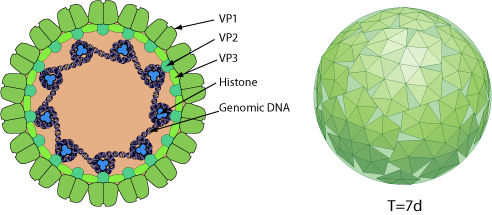VIRION

Non-enveloped capsid with a T=7d icosahedral symmetry, about 50 nm in diameter.
GENOME
Circular dsDNA about 5 kb in size, associated with cellular histones in a chromatin-like complex. Encodes for 5-9 proteins. On rare non-specific recombination, the viral genome can be integrated in host chromosome. This inactivates the integrated virus but can give the host cell a replicative advantage sometimes leading to malignant tumours.
GENE EXPRESSION
Transcription is nuclear, in two phases; early (replication), late (virion assembly/exit). 5-9 proteins are expressed from the two pre-MRNA by alternative splicing. All genes are transcribed by host RNA pol II.
REPLICATION
NUCLEAR
- Attachement of the viral proteins to host receptors triggers lipid-mediated endocytosis of the virus into the host cell.
- Virion transits through endoplasmic reticulum where host protein disulfide isomerases rearrange its capsid structure
- Export of misfolded virion to the cytoplasm possibly through host ERAD pathway
- Loss of VP1 in the low-calcium conditions of the cytosol
- Import of genomic DNA into host nucleus.
- Transcription of early genes (LT and sT genes)
- Replication of the DNA genome in the nucleus.
- Transcription of late genes encoding for structural proteins (VP1, VP2 and VP3).
- Assembly of new virions in nuclear viral factories.
- Virions are released by lysis of the cell.

